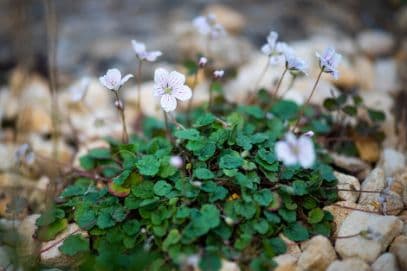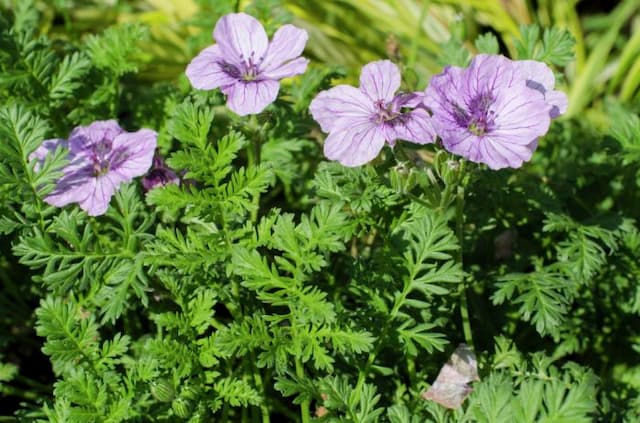Pink Geranium Pelargonium 'Pink Capricorn' (Sc)

ABOUT
The Pink Capricorn geranium is a striking plant known for its vibrant floral display. It boasts lush, rounded leaves that are soft to the touch, with a slightly scalloped edge that gives them a delicate, ornamental look. The foliage tends to be a rich, deep green, often with darker veins that add to the visual interest of the leaves. Atop these attractive leaves sit the flowers, the true showstoppers of the Pink Capricorn. The blooms are a soft, yet vivid pink color, presenting a bright and cheerful display. Each flower is made up of rounded petals that may have a slight ruffle at the edges, increasing their ornamental appeal. The blossoms are gathered in clusters, known as umbels, which create a full, lush look as if the plant is crowned with pink. These flowers not only add a splash of color to gardens or containers but they also frequently attract butterflies and other pollinators, bringing additional life and motion to the space they occupy. The overall impression of the Pink Capricorn geranium is one of a robust and lively plant that can provide a continuous pop of pink throughout its blooming season, adding a warm and inviting feel wherever it is planted.
About this plant
 Names
NamesSynonyms
Pink Capricorn Geranium, Zonal Geranium, Pelargonium 'Pink Capricorn'.
Common names
Pelargonium 'Pink Capricorn'
 Toxicity
ToxicityTo humans
Geraniums, which include the Pelargonium 'Pink Capricorn' variety, are generally considered non-toxic to humans. However, some individuals may experience mild irritation or an allergic reaction after handling the plant or ingesting parts of it. Ingesting significant amounts might cause minor symptoms such as an upset stomach, vomiting, or diarrhea, but severe poisoning is very rare.
To pets
Geraniums, including the Pelargonium 'Pink Capricorn', can be toxic to pets, particularly to cats and dogs. If ingested, they may cause a range of symptoms including vomiting, anorexia, depression, and dermatitis. In cats, symptoms might also include lethargy, increased heart rate, and hypothermia. It is advisable to keep geraniums out of reach of pets to prevent potential poisoning.
 Characteristics
CharacteristicsLife cycle
Perennials
Foliage type
Evergreen
Color of leaves
Green
Flower color
Pink
Height
1-2 feet (30-60 cm)
Spread
1-2 feet (30-60 cm)
Plant type
Herb
Hardiness zones
10
Native area
South Africa
Benefits
 General Benefits
General Benefits- Decorative Appeal: 'Pink Capricorn' Pelargoniums are known for their attractive blooms and foliage, enhancing the visual appeal of gardens and indoor spaces.
- Drought Tolerance: These plants have a good tolerance to dry conditions, reducing the need for frequent watering and making them suitable for xeriscaping.
- Easy Maintenance: 'Pink Capricorn' Pelargoniums are relatively low-maintenance, requiring minimal care once established, which suits gardeners of all skill levels.
- Versatility: They can be grown in containers, hanging baskets, or flower beds, offering flexibility in garden design and space utilization.
- Long Flowering Period: 'Pink Capricorn' Pelargoniums can bloom for an extended period, often from spring to fall, providing long-lasting color and interest.
- Insect Repelling: The scent of the foliage is known to repel certain insects, which can be beneficial in reducing pests around outdoor living areas.
- Aesthetic Variety: The 'Pink Capricorn' variety adds a unique pink coloration to the garden palette, allowing for creative color schemes and combinations.
 Medical Properties
Medical PropertiesThis plant is not used for medical purposes.
 Air-purifying Qualities
Air-purifying QualitiesThis plant is not specifically known for air purifying qualities.
 Other Uses
Other Uses- Potpourri: The scented leaves of Geranium can be dried and used in potpourri mixes to impart a pleasant fragrance to your home.
- Herbal Bath Sachets: Fresh or dried Geranium leaves can be added to bath sachets for an aromatic bathing experience.
- Crafts: The flowers and foliage can be used in pressed flower crafts or as natural die for fabrics and papers.
- Insect Repellent: Geranium can be grown in pots on patios or windowsills to help repel mosquitoes and other insects.
- Aromatherapy: The essential oil derived from Geranium is used in aromatherapy for its calming and uplifting properties.
- Drawer Fresheners: Dried leaves can be placed in drawers or closets to keep linens smelling fresh and to deter moths.
- Garden Borders: As an ornamental plant, Geraniums can provide attractive, low-maintenance borders for garden paths.
- Culinary Garnish: Although not a common practice, the petals of some Geranium species can be used as a colorful garnish for salads and desserts.
- Companion Planting: Geraniums can be planted in vegetable gardens to help attract beneficial insects and deter pests.
- Natural Dye: The pigments in Geranium flowers can be used to create natural dyes for textiles and crafts.
Interesting Facts
 Feng Shui
Feng ShuiThe Geranium is not used in Feng Shui practice.
 Zodiac Sign Compitability
Zodiac Sign CompitabilityThe Geranium is not used in astrology practice.
 Plant Symbolism
Plant Symbolism- Balance: The Geranium 'Pink Capricorn' often symbolizes balance, aligning with the zodiac sign of Capricorn known for its disciplined and grounded nature.
- Harmony: It is associated with harmony, perhaps due to its pleasant appearance and the soothing effect its presence can have in a home or garden.
- Fertility: In some traditions, geraniums are linked to fertility and the creation of new life, stemming from their lush and abundant growth habit.
- Health: The plant is also related to health, as historically, some species of geraniums were used for their medicinal properties.
- Protection: Some beliefs hold that geraniums can ward off negative energies and offer protection to those around them.
 Water
WaterGeraniums require careful watering to thrive. For Pelargonium 'Pink Capricorn', commonly known as a type of geranium, allow the soil to dry out between waterings to prevent root rot. Water deeply once the top inch of soil feels dry, which might be approximately once every 1-2 weeks, depending on environmental conditions. When watering, add water at the base of the plant until it begins to drain from the bottom of the pot. Typically, a pint or two depending on the size of the pot should be sufficient. During the active growing season in spring and summer, they may need more frequent watering, while in the cooler months, they'll require less.
 Light
LightGeraniums prefer bright, indirect sunlight to thrive. Pelargonium 'Pink Capricorn' should be placed in a location where it receives at least 4-6 hours of sunlight per day, but is protected from the intense midday sun, which can scorch the leaves. An east- or west-facing windowsill is typically ideal, providing the perfect balance of light. If grown outdoors, a spot that offers morning sun and afternoon shade is best.
 Temperature
TemperatureGeraniums enjoy moderate temperatures and a Pelargonium 'Pink Capricorn' does best in temperatures between 55 and 70 degrees Fahrenheit. These plants can survive minimally down to about 30 degrees Fahrenheit but should be protected from frost. They should not be exposed to temperatures above 80 degrees Fahrenheit for prolonged periods. The ideal growing conditions would keep the plant within this comfortable temperature range.
 Pruning
PruningGeraniums, including Pelargonium 'Pink Capricorn', should be pruned to encourage bushy growth and to maintain their shape. Remove dead or yellowing leaves and spent blooms regularly to promote new growth and more blooms. Pruning is best done in late winter or early spring before new growth begins. Cut back up to one-third of the plant, focusing on leggy stems to invigorate the plant for the coming season.
 Cleaning
CleaningAs needed
 Soil
SoilGeranium 'Pink Capricorn' thrives in well-draining potting soil with peat, perlite, and compost. Aim for a soil pH between 6.0 and 7.0 for optimal growth.
 Repotting
RepottingGeraniums like 'Pink Capricorn' should generally be repotted every 1-2 years or when they outgrow their current pot.
 Humidity & Misting
Humidity & MistingGeranium 'Pink Capricorn' prefers moderate humidity levels, however, it is quite adaptable and can tolerate indoor conditions well.
 Suitable locations
Suitable locationsIndoor
Place Geranium 'Pink Capricorn' in a bright spot with some direct sun.
Outdoor
Plant Geranium 'Pink Capricorn' in full sun to partial shade.
Hardiness zone
10-11 USDA
 Life cycle
Life cycleThe life of the Pelargonium 'Pink Capricorn', commonly known as Geranium 'Pink Capricorn', begins with seed germination, which occurs in warm, moist soil where the seeds sprout and develop into seedlings. Once the seedlings are established, they enter a period of vegetative growth where leaves and stems proliferate, and the plant grows in size. As the plant matures, it enters the blooming stage, characterized by the development of distinctive pink flowers which are essential for pollination and reproduction. Following pollination, the flowers produce seeds, completing the reproductive cycle. The geranium may also be propagated vegetatively through cuttings, which root and grow into new plants, thus bypassing the seed stage. Depending on the climate and care, geraniums can either be treated as annuals, completing this life cycle within a single growing season, or as perennials where they survive to regrow for multiple seasons.
 Propogation
PropogationPropogation time
Spring-Summer
The Pelargonium 'Pink Capricorn', commonly known as Geranium, is best propagated through stem cuttings. This can typically be done in late spring to early summer when the plant is actively growing. To propagate, a healthy stem about 4 to 6 inches (10 to 15 cm) long is cut just below a node, and the lower leaves are removed. The cutting should then be allowed to dry for a few hours to let the cut end callous over, which helps prevent rotting. The cutting is then dipped in rooting hormone and planted in a mix of perlite and peat or a similar well-draining potting mix, ensuring the node where the leaves were removed is buried. It's important to keep the soil moist but not waterlogged and place the cutting in a warm place with indirect light. Roots will generally develop in a few weeks, after which the new plant can be transplanted.




![Cranesbill [Blue Sunrise]](/_next/image?url=https%3A%2F%2Fplants-admin.emdemapps.com%2Fimages%2Fplants%2F%2Fimages%2F604b638d45948.png&w=640&q=75)




